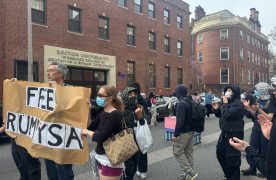In 2018, the United States averaged 132 suicides per day.
September is National Suicide Prevention Month. I’ve already noticed a sudden influx of Instagram stories reposting aesthetic graphics about how you should check in with your loved ones.
Don’t get me wrong — checking in is always extremely important to do. It’s also good to be reminded every now and then that being mentally unhealthy looks different for every person.
But ultimately, this month is about suicide prevention, an issue that requires systemic change, not just personal intentions. Similar to antiracism, bettering our approach to mental health requires not only individual work, but also legislative and societal change.
This is why I believe that the focus of this month should be on defunding the police.
For all the social advocacy our generation performs, as a society, we never seem to truly broach the subject of mental health. This is the result of stigmatization that makes the conversation around mental health seem shameful, more akin to walking across a minefield.
We were never taught how to support a friend who is neurodivergent or a loved one who is suffering through depression or anxiety, much less a more rare mental illness. Instead, symptoms, behaviors and coping mechanisms are shrouded in mystery or shrugged off as unattractive traits that some unfortunate souls simply must bear.
Far too often, I’ve witnessed a peer express concern over self harm or suicidal behavior, but in the same breath scoff at purported laziness, short attention spans, bad memory, brain fog, compulsions and so on.
The fact is, the signs start long before a suicide attempt is made. We need to invest in education systems that prepare us from a young age not only to recognize declining mental health in ourselves and others, but also to take care of ourselves, ask for help, and support friends or family members.
We all know that U.S. public schools’ health education is lacking in many areas, most ostensibly in sex ed. But these education systems require more funding to improve performance and create a lasting, positive impact on the mindsets of future generations. Facilitating healthy and open discussions will also help reduce both societal and internalized stigmas against certain topics.
Therefore, it’s crucial that we reallocate resources from overfunded police departments toward an improved education system.
Beyond schools, resources and educational programs must also cater to older communities and a variety of cultures. This will destigmatize mental health issues and help those who are unfamiliar understand that it’s a real, pressing issue that affects people’s lives.
Further, those who are statistically more vulnerable to suicide or unhealthy behavior must receive better access to resources that work for them. Mental health resources and treatment need to account for cultural differences.
American Indian or Alaska Native populations continually have higher rates of successful and attempted suicide, as well as suicidal thinking, when compared to other races, according to the Suicide Prevention Resource Center. Black, Asian or Hispanic individuals have much lower rates than Indigenous or white individuals — which may seem like a good thing until you remember that increased cultural stigma and underreporting limits accurate data collection.
The American Psychiatric Association found only one-third of Black Americans receive the mental health care they need. Another study found 63 percent of them believe mental illnesses are a sign of weakness.
Suicide also disproportionately affects other minority identity groups: gay, lesbian or bisexual youth are five times more likely to attempt suicide than their heterosexual counterparts.
At the intersection of sexuality, gender identity and race, racial and ethnic disparities in suicide attempts are made much more prominent. The Trevor Project reported in 2019 that BIPOC LGBTQ youth aged 13 to 24 had higher rates of reported suicide attempts than that of white non-Hispanic LGBTQ youth — 21 percent compared to 18 percent, respectively.
So, as we work toward destigmatizing mental health and investing in education, a pressing concern is our need for more mental health resources directed to the LGBTQ community, BIPOC and veterans, among other minority groups. We need better-funded resources so that they are affordable and accessible, as well as able to account for cultural differences, socioeconomic disparities and medical bias.
Even general resources for the masses are far from adequate right now. When someone calls the suicide hotline, for example, it is because they are facing a dire crisis. Yet people have been put on hold for upwards of 30 minutes or given dismissive and insensitive advice.
In reality, police who handle numerous mental health related calls do not have sufficient training to properly address the emergency. Each year, nearly 400,000 individuals with mental conditions who need psychiatric help are instead arrested and imprisoned behind bars, according to a 2019 report from the Treatment Advocacy Center.
Racial discrimination and excessive force also come into play during police encounters with neurodivergent or neuroatypical individuals. Police violence is even an issue of public health due to the racial trauma it can cause BIPOC. So why are the police overfunded when they aren’t even trained to handle these situations and, in fact, often exacerbate mental health crises?
Police departments across the country have received exorbitant amounts of funding while departments relating to mental health, trauma response or social services have received comparably less. A 2019 case study reported Chicago’s police department received 40.5 percent of the city’s funding while mental health services received 0.9 percent. This disparity is apparent in smaller cities as well, such as St. Louis.
This month, it’d be great to raise awareness about the need for funding in mental health services. It’d be great to donate a couple of dollars to the Teen Line, the Trevor Project, the Center for Suicide Awareness, the American Foundation for Suicide Prevention, the National Suicide Prevention Lifeline or the National Alliance on Mental Illness.
But our real goal should be defunding the police and focusing on a systemic change — from public school curriculums to the prioritization of mental health services. And these efforts should extend beyond just one month every year.
In Boston, Mayor Marty Walsh has already set an example by taking steps to remedy the gap through reallocating 20 percent of the Boston Police Department’s overtime funds to trauma teams, counseling services, public mental health services and other community resources.
By defunding the police, and more importantly, reallocating those funds to other community resources such as mental health services, programs and education, we can actually work to prevent suicide.
As nice as it is to have your friends and family be there for you, it’s not the same as professional help.















Well-written, insightful, and backed up by thorough research! A great read.